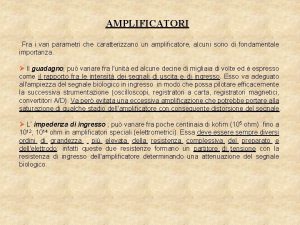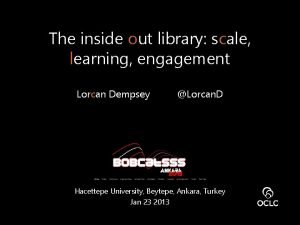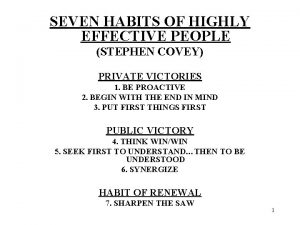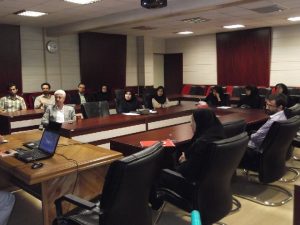Review 1 From the inside out name the

















- Slides: 17

Review 1. From the inside out name the layers of the Earth. Inner core-outer core-mantle (asthenosphere then lithosphere)-crust 2. What is the most abundant element in the crust? The atmosphere? Oxygen/Nitrogen 3. Name three types of plate boundaries and one feature they cause. Divergent-Rift valleys and mid ocean ridges Convergent-Subduction and volcanoes Transform-offset topography (all three cause earthquakes) 4. What forms volcanoes? Subduction, Divergence at mid ocean ridges and hot spots. the ring of fire 5. Most of the volcanoes on earth are found in _____________. 6. What are three types of seismic waves? Which is the most destructive? S waves, p waves and surface waves (most destructive) 7. Name the place where an earthquake originates. Where it surfaces. Focus/Epicenter 8. Name three types of rocks. Igneous, sedimentary and metamorphic 9. Name a mineral that is also a fossil fuel. What are two things it is used for? Coal/make electricity, heating and steel industry. 10. Which country has the most coal? Which country uses the most? U. S. /China 11. Name two environmental impacts of mining? Toxic groundwater/Acid mine drainage/habitat loss and fragmentation/erosion/soil pollution 12. Name two renewable energy sources and two non-renewable. Solar, wind, geothermal, hydro, and biomass/Coal, natural gas, oil (petroleum) Boiling points 13. Oil is refined based on ___________.

14. Calculate the number of acres required to produce 1, 000 gallons of oil in one year from (i) microalgae (ii) soybeans (i)1, 000 gal x 1 acre = 0. 1 acre 10, 000 gal (ii) 1, 000 gal x 1 acre = 20 acres 50 gal 15. Describe TWO environmental advantages that biodiesel production from microalgae offers over biodiesel production from the other crops listed in the table. Microalgae: Less land use = less habitat loss/less nutrient depletion of soil need less fertilizers less cultural eutrophication/less irrigation less chance of soil salinization, desertification and aquifer depletion/less soil erosion from decreased tilling/less pesticides less runoff into water.

16. Explain why burning biodiesel fuel has a different impact on atmospheric CO 2 concentrations than does burning fossil fuels. Biodiesel contains carbon that was recently in the atmosphere rather than fossil fuel carbon that was in the atmosphere long ago and has been sequestered in the Earth. Burning biodiesel dose not cause a net increase in carbon dioxide currently circulating in the atmosphere but burning fossil fuels does. 17. Discuss TWO benefits, other than those related to atmospheric impacts, of increased reliance on biodiesel fuels over the next 50 years. Biofuels are renewable resources and less likely to be exhausted/ Fossil fuels are nonrenewable Decreased reliance on imported fossil fuels/ Decreases political instability and results in a selfsufficient supply of energy Reduced land disturbance because of less fossil fuel extraction Reduced petroleum use/ Petroleum reserves will dwindle over the next 50 years Increased jobs and Increased profits for companies/ More jobs needed in the agricultural sector and industries in the agricultural sector will increase sales 18. Describe TWO economic or societal problems associated with producing fuel from corn. Increased prices for food (e. g. , beef, chicken, anything made with corn syrup)/increased demand may result of increased corn prices Energy shortages/Poor crop yields from drought etc. , result in less corn to produce energy Shortages of food for human consumption/ decreased supply of corn as food source Loss of jobs/ Lower demand for energy production jobs not associated with corn (e. g. , coal mining, petroleum engineering)

19. A B C Feature A is a subduction zone. One lithospheric plate is subducting (sinking) below another, largely due to differences in density (the denser plate sinks). This is an example of a convergent plate boundary. The Cascade Mountain Range in Washington State. Feature B is a divergent plate boundary. Lithospheric plates are moving apart. The space created between them is filled by hot magma coming apart. The Mid-Atlantic ridge/range is an example. When they form on continental crust, they are known as rift valleys, such as the African Rift Valley. Feature C is a hot spot. This is a place in the asthenosphere where the temperature is higher than average such that localized melting occurs. The Hawaiian Islands are an example. 20. Describe two ways in which evolution may occur as a consequence of plate tectonics. First, a divergent plate boundary could cause one land mass to be divided into two or more distinct parts, perhaps even separated by an ocean. For example, identical fossils can be found on the east coast of South Africa and the west coast of Africa. Different species would evolve from this common ancestor as a reaction to the different environments. Second, faulting occurring and may cause a river to be diverted. The new path of the river could divide a population into two and serve as a geographic barrier preventing gene flow.

Review 1. Besides drilling for crude oil what are other ways that we can obtain oil? Oil shale and Oil sand Matching: 2. Oil shale 3. Crude oil 4. Natural gas 5. Coal 6. Oil sand 4 5 6 2 3 Area with the most Russia United States Canada Western United states Saudi Arabia 4 5 3 6 2 Major component 5 Methane 4 Bituminous 3 Petroleum 2 Bitumen 6 Kerogen Environmental cost Releases sulfur Groundwater pollution Carbon dioxide release Tied up in rocks Uses and pollutes surface water to extract 7. What is the cleanest non renewable energy source? Natural Gas Matching: Who produces the most? 8. Solar 9 United States Followed by China 9. Hydroelectric 8 Germany 10. Biofuels 11 United States followed by France 11. Nuclear 10 United States followed by Brazil 12. Geothermal 13 China followed by Denmark 13. Wind power 12 United States followed by Iceland 11 12 13 9 8 10 Environmental Cost or problem Thermal pollution Few areas for energy production Not aesthetically pleasing Disrupts fish migratory patterns High cost to produce panels Can be grown and used unsustainably

Anaerobic methane digesters have been used for many years to reduce energy costs on farms throughout Europe and on some large farms in the United States. The methane can then be used to generate electricity or produce heat. For a certain dairy farm with 500 cows, the cost of installing a digester is approximately $400, 000. Assume that the farm uses 800, 000 kilowatthours (k. Wh) of electricity each year at a cost of $0. 10 per k. Wh. The waste from a single cow can produce 3. 0 k. Wh of electricity each day. 14. Describe the steps by which methane produced in the digester can be used to generate electricity. Methane can be burned to heat water that produces steam to spin turbines creating electricity 15. Discuss TWO environmental benefits that may result from the installation of an anaerobic methane digester. Reduction in the amount of methane released to the atmosphere/ Methane contributes to climate change (greenhouse gas) Reduction in runoff or spills of manure in local waterways/ Manure contains nutrients that lead to cultural eutrophication or fecal coliform contamination may spread disease Reduction in use of fossil fuels for electricity generation/Extends the supply of fossil fuel 16. Assuming that the cost of electricity remains constant and the farmer starts using the manure from the cows in an anaerobic digester to produce electricity on the farm, calculate: The number of k. Wh of electricity that can be produced in one year 500 cows × 3. 0 k. Wh × 365 days = 547, 500 k. Wh/year cow–day year

17. The amount of money the farmer can save in one year, NOT counting the installation cost of the digester. (You may round your answer to the nearest $1, 000. ) 547, 500 k. Wh × $0. 10 = $54, 750 ($55, 000) 18. The amount of time, in years, that it will take to recover the cost of installing an anaerobic digester on the farm. (You may round your answer to the nearest whole number of years. ) $400, 000/$55, 000 = 7. 2 years (or 7 years) 19. Calculate the minimum number of cows the farm would need to produce 800, 000 k. Wh of electricity per year. 800, 000 k. Wh year × 1 year × 365 days cow–day = 730. 5 cows = 731 cows 3 k. W 20. Identify two environmental consequences of coal combustion Sulfur released as SO 2 (acid deposition), Large amount of soot (Industrial grey smog), CO 2 (global warming) and produces the majority of atmospheric mercury and radioactive materials 21. Discuss three positive economic effects of coal mining Job creation by the mining companies increases local economies, and taxes paid to the government can be used for infrastructure and education. 22. Explain one way in which coal is mined Surface mining, mountain top removal, or open pit mining

23. According to the United States Energy Information Administration, the consumption of natural gas by the United States increases at 8 percent per year. Use the rule of 70: 70/8 = 8. 75 years 24. Identify and describe TWO water-related environmental problems associated with fracking. Ground water contamination: Fracking liquids or chemicals can contaminate drinking water and groundwater, or liquid waste stored in waste lagoons can leach into groundwater (aquifer) or drilling can allow methane (or natural gas)to seep into groundwater. Excessive water use or consumption: Considerable amounts of water are used in the fracking process. This can result in overdrafts of aquifers or water demands for the fracking process compete with water demands for drinking or irrigation (agriculture).

25. Natural gas is considered to be a better fossil fuel for the environment than coal is. Discuss TWO environmental benefits of using natural gas as a fuel compared to using coal. Fewer SOx are produced, resulting in less acid rain. Fewer NOx are produced, resulting in less acid rain and less photochemical smog. Less Hg is released. Harmful mining techniques are avoided; for example, no strip mining or mountaintop removal is required. Fewer particulates (soot) are released. Less CO 2 is produced. 26. Describe TWO environmental drawbacks, not related to water use, of using the fracking process to extract natural gas from shale. Habitat fragmentation/destruction can occur from setting up the drilling site or from building roads. Earthquakes can result from the drilling/fracking process. Methane can leak (into the atmosphere) during the process, resulting in an increase of greenhouse gases. Subsidence of the land can occur once fracking fluids are removed. Trucks and drilling equipment consume a nonrenewable fuel and release CO 2 27. Describe TWO negative environmental impacts associated with nuclear power. Spent nuclear waste (fuel): has to be stored for 10 half-lives in order to be considered safe. Thermal pollution from cooling operations (impacting surface waters). Nuclear accidents/plant failures: release of radioactive substances, resulting in contamination of soil, water, air, and living organisms.

Review 1. The half-life of Zn-71 is 2. 4 minutes. If one had 100. 0 g at the beginning, how many grams would be left after 7. 2 minutes has elapsed? 7. 2 / 2. 4 = 3 half-lives 100 becomes 50 becomes 25 becomes 12. 5 g 2. After 24. 0 days, 2. 00 milligrams of an original 128. 0 milligram sample remain. What is the half-life of the sample? 128 to 64 to 32 to 16 to 8 to 4 to 2 half lives = 6 24 days/6 half lives = 4 days 3. A reactor produces a certain unstable nuclide in a spent fuel rod which is removed from the reactor. Suppose the half-life of this nuclide is 2. 5 years. After 20 years what fraction of the original nuclide still remains? Each half life is 2. 5 years/ 5 years/ 10 years/ 20 years = 4 half live passed 1/16 remains 4. Gold-198 has a half-life of 2. 7 days. How many grams of radioactive gold remain in an original sample of 20 grams after 10. 8 days? 2. 7 days to 5. 4 days to 8. 1 days to 10. 8 days = 4 half lives 20 grams becomes 10 grams becomes 5 grams becomes 2. 5 grams becomes 1. 25 grams

5. Most of the coal mined in the United States today comes from surface (strip) mines. In surface mining, the vegetation, soil, and rock covering the coal (referred to as overburden) are removed and set aside. Describe the steps that should be taken to restore the land after the overburden has been replaced. Recontouring/regarding land to its original topography Replacing and/or adding topsoil and/or nutrients as needed to improve soil quality Replanting with native vegetation/fast growing species/early successional species Monitoring for either 5 or 10 years, depending on location 6. Explain why the restoration of the land would likely be more difficult in an arid climate (less than ten inches of precipitation per year). It may be difficult to re-establish vegetation due to low precipitation, low fertility of soils in arid climates, because of the water-holding characteristics of the soil in arid climates. As a consequence of the slow growth of vegetation the reclamation may be prolonged because of wind or water-related erosion, runoff, and landslides.

7. Answer the questions below regarding the heating of a house in the Midwestern United States. Assume the following: The house has 2000 square feet of living space. 80000 BTU's of heat per square foot are required to heat the house for the winter. Natural Gas is available at a cost of $5. 00 per thousand cubic feet. One cubic foot of natural gas supplies 1000 BTU's of heat energy. The furnace in the house is 80 percent efficient. Calculate the following, showing all the steps of your calculations, including units. The number of cubic feet of natural gas required to heat the house for one winter. 2000 sq feet x 80000 BTU x 1 cubic ft = 160, 000 cubic ft sq foot 1000 BTU 8. The cost of heating the house for one winter 160, 000 cubic ft x $5. 00 = $800 1000 cubic ft 8. The United States Department of Energy recently chose Yucca Mountain in Nevada as the site for the deep underground burial of high-level radioactive waste. Describe THREE characteristics of an ideal deep underground storage site for high-level radioactive waste. Large enough to accept current and future volume of waste Not near fault lines or volcanos Remote location far from human settlements At least 2000 feet below surface Dry climate to minimize precipitation and percolation

9. Identify TWO other options that have been suggested for the long-term management of radioactive waste. Discuss the feasibility of each method. Storage under Antarctic or Greenland ice sheet/Limited by technology and melting ice Rocket to space or sun/Limited by cost and accident during launch Store on the moon/same as above Deep sea storage/limited by danger of leaking containers Ship to other countries/limited by ethics and transportation concerns Reduce energy demands/limited by public’s willingness to do so 10. Exposure to high levels of ionizing radiation has adverse effects on human health and can result in immediate death. Identify one sublethal adverse effect on human health that can result from exposure to ionizing radiation, and explain how this effect is caused by the radiation. Cancer or tumors/DNA damage Burns/Cell tissue damage Hair loss/Cell death Damage to fetus/DNA damage 11. The United States consumes approximately 20 million barrels of oil per day. According to the USGS estimate, for how many days would the technically recoverable oil resource in ANWR supply the total United States demand for oil? (ANWR could contain up to 10 billion barrels) 10 x 109 barrels =. 5 x 103 days or 500 days (Remember to subtract exponents when dividing) 20 x 10 6 barrels per day 10, 000, 000 = 500 days 20, 000

Review 1. What are two major environmental problems with hybrid electric cars? Pure electric cars? Hydrogen fuel cell cars? Hybrid electrics/Still produce CO 2 and smog (use gas) Electric/Can indirectly produce pollutants from charging if electricity is made from coal etc. Hydrogen/Storing H 2 (For all three expensive of batteries and disposing and recycling of 2. Green or living roofs are common is Europe. Why are they not widely used in the U. S. ? them) 3. Simply explain passive We would have to how water them solar works. 4. Explain how photovoltaic cells work. is their drawback? Using well placed windows and vents to What heat and coolmajor the home 5. Explain how solar power could beaused to power a remote village? does this differ Sunlight excites electrons producing current that can be used to run How electronics/Cost from the normal solar power used on California homes? Off grid systems can stand alone and power a village. Our solar is connected to DWP so we 6. How can the burning of biomass cause soil Can depletion? can use both solar and generated electricity. sometimes sell power back. 7. Howcow are biofuels like ethanol produced? What produced Burning dung removes nutrients from the soil flammable and releasegas them into thethe air. same way? 8. Name and describe(fermentation)/Methane two energy laws. Anaerobic respiration

9. Nuclear power plants have been described as being part of the solution to the problem of the United States’ dependency on foreign energy. Currently, some 20 percent of the electricity produced in the United States is generated by nuclear power. Describe one positive impact that a nuclear power plant might have on air pollution. Reduces NOx and SOx released into the atmosphere from coal burning power plants. It also releases less CO 2 than alternatives. 10. Opponents of nuclear power plants point out the problems caused by thermal pollution of nearby rivers. Describe how thermal pollution occurs and one method to reduce this problem. In order to cool the reactor core water is used from nearby oceans or rivers and released back into the ecosystem heated. Use a series of pipes to allow the water to cool before it is released. 11. Describe what makes a resource renewable or nonrenewable. Give a specific example of a renewable resource and of a nonrenewable resource used to create energy. A renewable resource is an organic natural resource which can replenish to overcome usage and consumption, either through biological reproduction or other naturally recurring processes if used sustainably. A non-renewable resource of economic value that cannot be readily replaced by natural means on a level equal to its consumption Non-renewable: Oil, Natural gas, Coal (fossil fuel hydrocarbons) Nuclear (Uranium) Renewable: Biofuels and Methane from anaerobic respiration (hydrocarbons) Wind, Solar, Hydroelectric, Geothermal (non-hydrocarbons)

12. Describe one environmental benefit and one environmental cost of photovoltaic systems. Use does not contribute to atmospheric pollution Use does not contribute nuclear waste and thermal pollution Environmental cost of manufacturing the solar panels can increase air pollution and uses energy. Production of solar panels can cause water pollution and produce toxic waste 13. Describe TWO ways that government and/or industry could promote the use of photovoltaic power systems for homeowners in the future. Give tax credits to homeowners with pv systems Subsidize the cost of pv systems so homeowners can afford them Mandate the use and installation of pv systems for new home construction 14. Estimate the potential reduction in petroleum consumption (in gallons of gasoline per year) that could be achieved in the United States by introducing electric vehicles under the following assumptions: 1. The mileage rate for the average car is 25 miles per gallon of gasoline. 2. The average car is driven 10, 000 miles per year. 3. The United States has 150 million cars. 4. 10 percent of United States cars could be replaced with electric vehicles. 150, 000 cars x 10, 000 miles Year x per gallon x 0. 1 (%of replaced cars) = 6 billion 25 miles

15. Some people have suggested that electric vehicles only shift the emission of air pollutants from dispersed sources to point sources. Explain and defend or refute this statement. Cars run on oil are considered non-point sources of pollution as the drive around, while electric cars are a point source if they get their energy generated from a power plant. If the cars get their electricity from fossil fuels they are a point source. If the cars get their energy from wind or solar they are not shifting the emissions.
 Figurative language in the song one thing by one direction
Figurative language in the song one thing by one direction Patch clamp amplifier axon
Patch clamp amplifier axon Schachter's two factor theory
Schachter's two factor theory Inside out francisco jimenez
Inside out francisco jimenez Inside out and back again vocabulary
Inside out and back again vocabulary Mothering from the inside out
Mothering from the inside out Inside out patch clamp
Inside out patch clamp Inside out
Inside out Organizing from the inside out
Organizing from the inside out Inside out guessing the feelings
Inside out guessing the feelings Inside out idea generation
Inside out idea generation Shodor function machine
Shodor function machine Kim ha poem
Kim ha poem Inside out library
Inside out library Inside out hillsong
Inside out hillsong Windows 7 inside out
Windows 7 inside out 7 habits paradigm
7 habits paradigm Interaktib na mambabasa
Interaktib na mambabasa

































